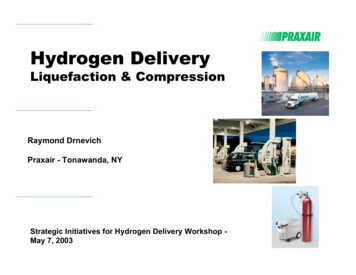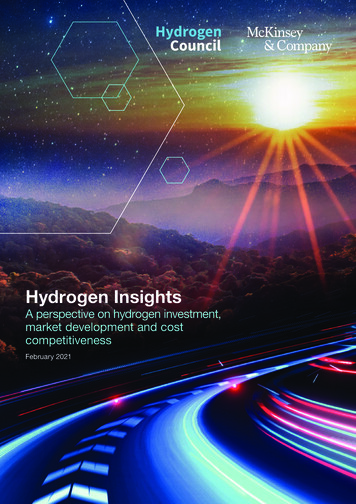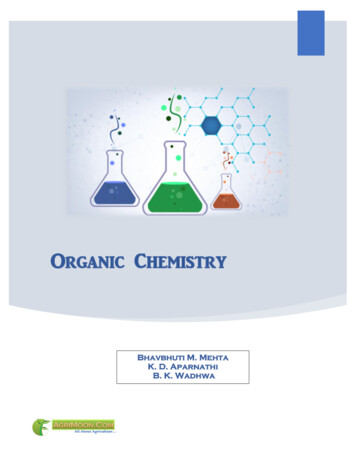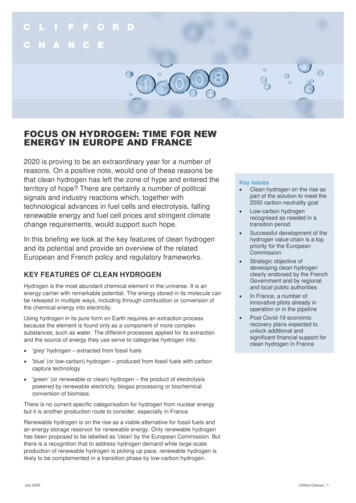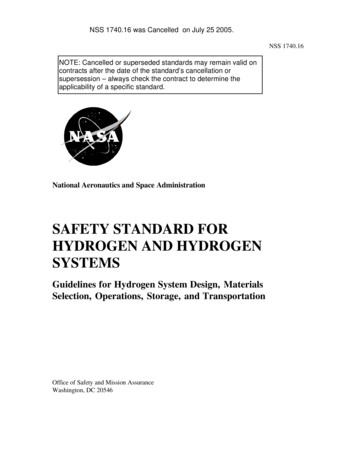
Transcription
NSS 1740.16 was Cancelled on July 25 2005.NSS 1740.16NOTE: Cancelled or superseded standards may remain valid oncontracts after the date of the standard’s cancellation orsupersession – always check the contract to determine theapplicability of a specific standard.National Aeronautics and Space AdministrationSAFETY STANDARD FORHYDROGEN AND HYDROGENSYSTEMSGuidelines for Hydrogen System Design, MaterialsSelection, Operations, Storage, and TransportationOffice of Safety and Mission AssuranceWashington, DC 20546
PREFACEThis safety standard establishes a uniform Agency process for hydrogen systemdesign, materials selection, operation, storage, and transportation. This standardcontains minimum guidelines applicable to NASA Headquarters and all NASA FieldCenters. Centers are encouraged to assess their individual programs and developadditional requirements as needed. “Shalls” and “musts” denote requirementsmandated in other documents and in widespread use in the aerospace industry.This standard is issued in loose-leaf form and will be revised by change pages.Comments and questions concerning the contents of this publication should bereferred to the National Aeronautics and Space Administration Headquarters,Director, Safety and Risk Management Division, Office of the Associate for Safetyand Mission Assurance, Washington, DC 20546.Frederick D. GregoryAssociate Administrator forSafety and Mission AssuranceEffective Date: Feb.12, 1997i
ACKNOWLEDGMENTSThe NASA Hydrogen Safety Handbook originally was prepared by Paul M. Ordin,Consulting Engineer, with the support of the Planning Research Corporation. Thesupport of the NASA Hydrogen-Oxygen Safety Standards Review Committee inproviding technical monitoring of the standard is acknowledged. The committeeincluded the following members:William J. Brown (Chairman)NASA Lewis Research CenterCleveland, OHHarold BeesonNASA Johnson Space CenterWhite Sands Test FacilityLas Cruces, NMMike PedleyNASA Johnson Space CenterHouston, TXDennis GriffinNASA Marshall Space Flight CenterAlabamaColeman J. BryanNASA Kennedy Space CenterFloridaWayne A. ThomasNASA Lewis Research CenterCleveland, OHWayne R. FrazierNASA HeadquartersWashington, DCThe special contributions provided by Grace Ordin are noted. Also acknowledgedare the contributions provided by Carol A. Vidoli and, particularly, William J.Brown of NASA Lewis Research Center for their aid in reviewing, organizing, andediting this handbook; Fred Edeskuty of Los Alamos National Laboratory forinformation on slush hydrogen, and William Price of Vitro Corporation for hisrevision. This revision was prepared and edited by personnel at the NASA JohnsonSpace Center White Sands Test Facility. This document was extensively reviewedby experts at the various NASA centers, and their comments and suggections wereinstrumental in making the manual as complete and accurate as possible. Theexpertise of these professionals in the area of hydrogen system hazards, materials,selection, design, and operation is gratefully acknowledged.iii
ABOUT THIS DOCUMENTThis document and its companion document, Safety Standard for Oxygen andOxygen Systems (NSS 1740.15 1996), are identified as Tier 2 Standards andTechnical Requirements in the NASA Safety and Documentation Tree (NHB 1700.11993). The information presented is intended as a reference to hydrogen design andpractice and not as an authorizing document. The words “shall” and “must” areused in this document to indicate a mandatory requirement, and the authority for therequirement is given. The words “should” and “will” are used to indicate arecommendation or that which is advised but not mandatory.The information is arranged in an easy-to-use format. The reader will find thefollowing useful to note: A numbered outline format is used so information can be readily found andeasily cited. An index is provided in Appendix H to assist the reader in locating informationon a particular topic. Acronyms are defined when introduced, and a tabulation of acronyms used in thedocument is provided in Appendix F. The figures and tables referenced in the text are located in the appendices. All sources are referenced so the user can verify original sources as deemednecessary. References cited in the main body of the text can be found inChapter 10, and references introduced in an appendix is cited in that appendix.The latest revisions of codes, standards, and NASA directives should be usedwhen those referenced are superseded. The International System of Units (SI) is used for primary units, and USCustomary units are given in parentheses following the SI units. Some of thetables and figures contain only one set of units.v
TABLE OF CONTENTSParagraphPageCHAPTER 1: BASIC HYDROGEN SAFETY LE DOCUMENTS1-5103PERSONNEL TRAINING1-5104USE OF INHERENT SAFETY FEATURES1-7105CONTROLS1-9106FAIL-SAFE DESIGN1-10107SAFETY1-10108WAIVER PROVISIONS1-11CHAPTER 2: PROPERTIES AND HAZARDS OF HYDROGEN200TYPICAL PROPERTIES2-1201TYPES OF HAZARDS2-3202FLAMMABILITY AND IGNITION OF HYDROGEN2-14203DETONATION2-24204CHARACTERISTIC PROPERTIES OF GH22-29205CHARACTERISTIC PROPERTIES OF LH22-35206CHARACTERISTIC PROPERTIES OF SLH22-36CHAPTER 3: MATERIALS FOR HYDROGEN SERVICE300CONSIDERATIONS FOR MATERIALS SELECTION3-1301HYDROGEN EMBRITTLEMENT3-7302THERMAL CONSIDERATIONS IN MATERIALS SELECTION3-11CHAPTER 4: HYDROGEN FACILITIES400SAFETY POLICY4-1401SAFETY REVIEWS4-2402GENERAL FACILITY GUIDELINES4-6vii
TABLE OF CONTENTS (continued)ParagraphPage403BUILDINGS AND TEST CHAMBERS4-12404CONTROL ROOMS4-18405LOCATION AND QUANTITY-DISTANCE GUIDELINES4-19406EXCLUSION AREAS4-29407PROTECTION OF HYDROGEN SYSTEMS ANDSURROUNDINGS4-32408FIRE PROTECTION4-36409DOCUMENTATION, TAGGING, AND LABELING OFSTORAGE VESSELS, PIPING, AND COMPONENTS4-39410INSTRUMENTATION AND MONITORING4-42411EXAMINATION, INSPECTION, AND RECERTIFICATION4-46CHAPTER 5: HYDROGEN STORAGE VESSELS, PIPING, ANDCOMPONENTS500GENERAL REQUIREMENTS5-1501STORAGE VESSELS5-3502PIPING SYSTEMS5-15503COMPONENTS5-25504OVERPRESSURE PROTECTION OF STORAGE VESSELS ANDPIPING SYSTEMS5-43505HYDROGEN VENT AND FLARE SYSTEMS5-49506CONTAMINATION5-55507VACUUM SYSTEM5-60CHAPTER 6: HYDROGEN AND HYDROGEN FIRE DETECTION600HYDROGEN DETECTION6-1601HYDROGEN FIRE DETECTION SYSTEMS6-9CHAPTER 7: OPERATING PROCEDURES700GENERAL POLICY7-1viii
TABLE OF CONTENTS (continued)Paragraph701PageSTORAGE AND TRANSFER PROCEDURES7-10CHAPTER 8: TRANSPORTATION800GENERAL8-1801TRANSPORT ON PUBLIC THOROUGHFARES8-3802TRANSPORT ON SITE CONTROLLED THOROUGHFARE8-6803TRANSPORTATION EMERGENCIES8-10CHAPTER 9: EMERGENCY PROCEDURES900GENERAL9-1902TYPES OF EMERGENCIES9-4902ASSISTANCE IN EMERGENCIES9-10903FIRE SUPPRESSION9-11904FIRST-AID PROCEDURES FOR CRYOGENIC-INDUCEDINJURIES9059-15SAFEGUARDS FOR ENTERING PERMIT-REQUIREDCONFINED SPACES9-16CHAPTER 10: REFERENCESAPPENDIX A: TABLES AND FIGURESA-1APPENDIX B: ASSESSMENT EXAMPLESB-1APPENDIX C: SCALING LAWS, EXPLOSIONS, BLAST EFFECTS, ANDFRAGMENTATIONC-1APPENDIX D: CODES, STANDARDS, AND NASA DIRECTIVESD-1APPENDIX E: RELIEF DEVICESE-1APPENDIX F: ABBREVIATIONS AND ACRONYMSF-1APPENDIX G: GLOSSARYG-1APPENDIX H: INDEXH-1ix
LIST OF FIGURESFiguresPageA1.1Equilibrium Percentage of Para-hydrogen vs. TemperatureA-3A1.2Enthalpy of Normal Hydrogen ConversionA-4A1.3Vapor Pressure of Liquefied Para-hydrogen (TP to NBP)A-5A1.4Vapor Pressure of LH2 (NBP to CP)A-6A1.5Vapor of Normal and Para-hydrogen Below the Triple PointA-7A1.6Comparison of densities and bulk Fluid Heat Capacities for Slush,Triple-Point liquid, and NBP Liquid Para-hydrogenA-8Proposed Phase Diagram (P-T) for Solid Hydrogen at VariousOtho-hydrogen Mole FractionsA-9A1.7A1.8Proposed Phase Diagram (V-T Plane) for Solid Normal HydrogenA-10A1.9Specific Heat (Heat Capacity) of Saturated Solid HydrogenA-11A1.10Melting Line from Triple Point to Critical Point Pressurefor Para-hydrogenA-12Flammability Limits at a Pressure of 101.3 kPa (14.7 psia)and a Temperature of 298 K (77 F)A-37Effects of N2, He, CO2, and H2O Diluents on FlammabilityLimits of Hydrogen in Air at 101.3 kPa (14.7 psia)A-38Effects of Halocarbon Inhibitors on Flammability Limits ofHydrogen-Oxygen Mixtures at a Pressures of 101.3 kPa (14.7 psia)and a Temperature of 298 K (77 F)A-39Distance for Fireball Radiation Flux Induced Third Degree Burnsper Amount of Fuel Burned at a Thermal Radiation Intensityof 134 kJ/m2 (11.8 Btu/ft2)A-40Radiation Intensity as a Function of Exposure Time or Escape TimeA-41A2.1A2.2A2.3A2.4A2.5x
LIST OF FIGURES (continued)FiguresPageA2.6Variation in Distance from a Hydrogen Fire for a Thermal RadiationExposure of 2 cal/cm2 for an Exposure Duration of 10 sA-42A2.7Minimum Dimensions of GH2-Air Mixtures for Detonation at101.3 kPa (14.7 psia) and 298 K (77 F)A-43Detonation Cell Widths for Hydrogen-Air Mixtures at101.3 kPa (14.7 psia)A-44Minimum Initiation Energies for Direct Detonation ofHydrogen-Air MixturesA-45A4.1Flame Dip as a Function of Stack Diameter an Hydrogen FlowA-65A4.2Blowout and Stable Flame RegionA-66A4.3Flame Shape in CrosswindsA-67A4.4Minimum Flow Rate for Non-Stratified, Two Phase Hydrogen andNitrogen Flow for Pipeline Fluid Qualities Below 95% and 98%A-68Liquid Hydrogen Flow Rate Limits to Avoid Excessive CooldownStresses in Thick-wall Piping Sections Such as Flanges for 304 SSand 6061 AlA-69Liquid Nitrogen Flow Rate Limits to Avoid Excessive CooldownStresses in Thick-wall Piping Sections Such as Flanges for 304 SSand 6061 AlA-70Charpy Impact Strength as a Function of Temperature forVarious MaterialsA-75Yield and Tensile Stress of 5086 Aluminum as a Function ofTemperatureA-76Yield and Tensile Stress of AISI 430 Stainless Steel as a Functionof TemperatureA-77Thermal Expansion Coefficient of Copper as a Functionof TemperatureA-78A2.8A2.9A4.5A4.6A5.1A5.2A5.3A5.4xi
LIST OF FIGURES (continued)FiguresA5.5PageTotal Linear Thermal Contraction as a Function of Temperaturefor Several MaterialsA-79A6.1Irradiance of Common IR SourcesA-93A6.2Atmospheric IR Transmission and H2-Air-Flame EmissionA-94A6.3UV/VIS/Near-IR EmissionsA-95A6.4Flame ComponentsA-95xii
LIST OF TABLESTablesA1.1PageSelected Thermophysical, Chemical, and Combustion Propertiesof Gaseous, Liquefied, Slush and Solid Para-hydrogenA-13A1.2Fixed Point Properties of Normal HydrogenA-17A1.3Thermodynamic Properties of the Hydrogen Solid-Vapor TwoPhase RegionA-19Thermodynamic Properties of the Hydrogen Solid-Liquid TwoPhase RegionA-20A1.5Molar Volume of Compressed Solid Para-hydrogenA-21A1.6Thermal Expansion of Solid Para-hydrogenA-22A2.1Potential Ignition SourcesA-46A2.2Flammability LimitsA-47A2.3Effects of Diluents on Flammable Range for Hydrogen in AirA-48A2.4Inhibitor for Extinction of Hydrogen Diffusion FlamesA-49A2.5Critical Radiant Flux LevelsA-50A3.1Order of Preference for Location of GH2 Storage SystemsA-53A3.2Quantity-Distance Requirements for Nonpropellant GH2 Systemsfor Outdoor LocationsA-54A3.3Order of Preference for Locations of LH2 Storage SystemsA-55A3.4Quantity-Distance Requirements for Nonpropellant LH2 Systemsfor Outdoor LocationsA-56A3.5Liquid Propellant Hazard and Compatibility GroupsA-57A3.6Explosive Equivalent Factors for Liquid PropellantsA-58A3.7Safe Quantity-Distance Relationships for LH2 Storage for HazardA1.4xiii
Group III MaterialsA-59xiv
LIST OF TABLES (continued)TablesA3.8PageSeparation and Intraline Quantity-Distance Values forMixed PropellantsA-61A4.1Summary of Liquefied Hydrogen Spill DataA-71A5.1Summary of Material Compatibility for Hydrogen ServiceA-80A5.2A Selection of Recommended Materials for Typical ApplicationsA-81A5.3Minimum Temperatures and Basic Allowable Stresses in Tensionfor Selected MetalsA-82Elastic Properties of Selected Materials at Room Temperature andLiquid Hydrogen TemperatureA-84Mechanical Properties of Selected Materials at Room Temperatureand Liquid Hydrogen TemperatureA-85Thermal Properties of Selected Materials at Room Temperature andLiquid Hydrogen TemperatureA-86A5.7Typical Characteristics of Hydrogen Embrittlement TypesA-87A5.8Susceptibility of Materials to Embrittlement in Hydrogen at10,000 psi and 72 FA-88Comparison Effects of Air, Helium, and Hydrogen Exposure onSelected Aluminum, Nickel, and Copper AlloysA-89A6.1Typical Hydrogen Gas DetectorsA-96A6.2A Survey and Analysis of Commercially Available Hydrogen Sensors A-97A6.3Sensitivity Limits of Hydrogen DetectorsA-98A6.4Typical Hydrogen Fire DetectorsA-99A7.1Hydrogen Accidents - IndustrialA-103A7.2Hydrogen Accidents - Ammonia PlantsA-104A5.4A5.5A5.6A5.9xv
LIST OF TABLES (continued)TablesPageA7.3Hydrogen Accidents - AerospaceB1Detonation Pressures and TemperaturesB-2B2Deflagration PressuresB-4B3Liquid-Lockup Pressure ChangeB-6B4Minimum Separation Distances for Siting the LH2 Dewar inExample 6B-20D1Selection of Federal Regulations for Hydrogen TransportationD-17E1Considerations for Relief Devices in LH2 PipelinesxviA-105E-6
CHAPTER 1: BASIC HYDROGEN SAFETY GUIDELINESNote: Hydrogen shall be stored, handled, and used so life and health arenot jeopardized and the risk of property damage is minimized.100SCOPEThis handbook is a central agency document containing guidelines for safelystoring, handling, and using hydrogen in gaseous, liquid, or slush form,whether used as a nonpropellant or propellant. Each designer, user,operator, maintainer, assurance person, and designated project manager isresponsible for incorporating the appropriate requirements of this guidelinedocument into their projects or facilities. However, use of this guidelinedocument does not relieve the designer, user, operator, maintainer, andassurance person and designated managers of professional responsibility orallow them to preclude the exercise of sound engineering judgment.101INTRODUCTIONa.General.(1)The purpose of the Hydrogen Safety Handbook is to provide apractical set of guidelines for safe hydrogen use. For thepurposes of this handbook, hydrogen may refer to the gaseous(GH2), to the liquefied (LH2), and/or slush (SLH2) form.Specific or special considerations for each form will bedelineated. This handbook contains chapters on properties andhazards, facility design, design of components, materialscompatibility, detection, and transportation. It also coversvarious operational issues and emergency procedures. Theintent of this handbook is to provide enough information that itcan be used alone, but at the same time, reference data sourcesthat can provide much more detail if required. Anyinformation contained herein on hazards and use of hydrogenis based on current knowledge and is subject to change asmore testing is completed and evaluated.(2)Federal and state mandatory regulation shall take precedenceover NASA directives in the event of conflicting requirements.A primary policy of NASA is that when requirements conflict,the most stringent shall apply (NSS 1740.11 1993).101a1-1
101bb.Nonpropellant Use.The following standards apply and shall be followed for hydrogenused as a nonpropellant:c.(1)29 CFR 1910.119 (1996) sets requirements for hazard analysisfor systems involving 4535 kg (10,000 lb) or more ofhydrogen in any form.(2)29 CFR 1910.103 (1996) sets requirements for GH2 systems.This regulation does not apply to single GH2 systems usingcontainers having a total hydrogen content of less than 11 CM(400 CF), measured at 101.3 kPa (14.7 psia) and 294.1 K(70 F). The regulation shall apply where individual systems,each having a total hydrogen content of less than 11 CM(400 CF), are located less than 1.5 m (5 ft) from each other.(3)29 CFR 1910.103 (1996) sets requirements for LH2 systems.This regulation does not apply to portable containers having atotal LH2 content of less than 150 L (39.63 gal), nor to a LH2system with a content greater than 283,910 L (75,000 gal).(4)All pressure vessels for hydrogen service shall be designed,constructed, and tested in accordance with ASME Boiler andPressure Vessel Code (BPVC) (1995) and NMI 1710.3(1994), NSS/HP 1740.1 (1974), and NSS 1740.4 (1976). Theappropriate standards from these codes shall be used foraerospace pressure vessels. All piping systems for hydrogenservice shall be designed, constructed, and tested inaccordance with ANSI/ASME B31.1 (1995) andANSI/ASME B31.3 (1996) as appropriate.Propellant Use.The following standards and guidelines apply and shall be followedfor LH2 used as a propellant:(1)29 CFR 1910.119 (1996) sets requirements for hazard analysisfor systems involving 4535 kg (10,000 lb) or more ofhydrogen in any form.1-2
d.(2)29 CFR 1910.103 (1996) sets requirements for LH2 systemsexcept for the requirements for quantity and distance sitingand for personnel monitoring.(3)NSS 1740.12 (1993)(DoD 6055.9 1992) sets requirements forsiting LH2 storage in relation to facilities and other propellantsand chemical storage and for personnel monitoring.(4)All pressure vessels for hydrogen service shall be designed,constructed, and tested in accordance with ASME BPVC(1995) and NMI 1710.3 (1994), NSS/HP 1740.1 (1974), andNSS 1740.4 (1976). The appropriate standards from thesecodes shall be used for aerospace pressure vessels. All pipingsystems for hydrogen service shall be designed, constructed,and tested in accordance with ANSI/ASME B31.3 (1996).SLH2 and Solid Hydrogen.No standards specifically apply to SLH2 and solid hydrogen atpresent. It is suggested that when the total mass of these materials inthe system being considered is equivalent to the amounts cited in101.b(1) and 101.b(3) that these reference standards be applied.Except for supplying limited property data in Appendix A1, solidhydrogen is not discussed further.e.Minimum Quantities.The authority having jurisdiction (AHJ) at the controlling NASAcenter is responsible and shall establish requirements for safe storageand use that shall protect all personnel and facilities, for hydrogensystems in quantities below the minimum quantity specified in theabove standards and guidelines.f.Other Facilities.Those facilities, equipment, and test articles that do not meet thedefinitions of GH2 or LH2 systems as stated in the standards andguidelines above but are in hydrogen service shall have applied fortheir design, construction, testing, and use 29 CFR 1910.103 (1996),29 CFR 1910.119 (1996), NSS 1740.12 (1993), and other standardsas directed by the AHJ at the controlling NASA center.101f1-3
101gg.102Retroactivity.(1)An existing system for hydrogen used as a nonpropellant notin strict compliance with the provisions of these standards andguidelines shall be permitted to be continued in use wheresuch use does not constitute a distinct hazard to life oradjoining facilities (NFPA 50A 1994 and NFPA 50B 1994).(2)Existing facilities for LH2 used as a propellant not incompliance with current standards may continue to be used forthe balance of their functional lives, as long as currentoperations present no significantly greater risk than thatassumed when the facility was originally designed, and it canbe demonstrated clearly that a modification to bring thefacility into compliance is not feasible. However, the facilitymust be brought into compliance with current standards (NSS1740.12 1993) in the case of a major renovation.APPLICABLE DOCUMENTSInformation on safe use of hydrogen systems is cited in each section. Unlessotherwise specified, the latest revision of documentation shall be used. Thelatest revision applies in the event of conflict. Unit conversions areconsistent with ANSI/IEEE Std 268 (1992).103PERSONNEL TRAININGa.Hydrogen Handling Training.Personnel handling hydrogen or designing equipment for hydrogensystems must become familiar with the physical, chemical, andspecific hazardous properties of GH2, LH2, and SLH2. Trainingshould include detailed safety programs that recognize humancapabilities and limitations. The goal of the safety program is toeliminate accidents and to minimize the severity of accidents thatoccur (NHB 1700.1 1993). Appendix B, Example 12 provides asummary of typical information that may be presented intraining/certification of liquid hydrogen handlers.1-4
b.Designer Training.Personnel involved in equipment design and operations planning mustbe trained to carefully adhere to accepted standards and guidelines andcomply with the regulatory codes (NHB 1700.1 1993).c.Operator Certification.Operators must be certified for handling GH2, LH2, and SLH2, asappropriate, and in the emergency procedures for spills and leaks.Operators must be kept informed of any changes in safety proceduresand facility operations (NHB 1700.1 1993 and 29 CFR 1910.1031996).d.Hazard Communication Program.The AHJ at the controlling NASA center shall develop, implement,and maintain at the workplace a written hazard communicationsprogram for their workplaces (29 CFR 1910.1200 1996).e.Annual Review.Each NASA installation will annually review all operations beingperformed at the installation to ensure that the safety training programis working effectively and to identify and enter into the program allpotentially hazardous jobs in addition to jobs designated mandatory.Employee safety committees, employee representatives, and otherinterested groups should be provided an opportunity to assist in theidentification process (NHB 1700.1 1993).104USE OF INHERENT SAFETY FEATURESa.Hazards Elimination.Regardless of quantity, all hydrogen systems and operations must bedevoid of hazards by providing adequate ventilation, designing andoperating to prevent leakage, and eliminating potential ignitionsources.b.Barriers.Barriers or safeguards should be provided to minimize risks andcontrol failures.104b1-5
104cc.Safety Systems.Safety systems should be installed to detect and counteract or controlthe possible effects of such hazards as vessel failures, leaks and spills,embrittlement, collisions during transportation, vaporization systemfailures, ignitions, fires and explosions, cloud dispersions, and theexposure of personnel to cryogenic or flame temperatures.d.Safe Interface.A safe interface must be maintained under normal and emergencyconditions so at least two failures occur before hazardous events couldlead to personal injury, loss of life, or major equipment or propertydamage.105CONTROLSa.Warning Systems.Warning systems should be installed to detect abnormal conditions,measure malfunctions, and indicate incipient failures. Warningsystem data transmissions with visible and audible signals should havesufficient redundancy to prevent any single-point failure fromdisabling the system.b.Flow Controls.Safety valving and flow regulation should be installed to adequatelyrespond for protection of personnel and equipment during hydrogenstorage, handling, and use.c.Safety Features.System and equipment safety features should be installed toautomatically control the equipment required to reduce the hazardssuggested by the triggering of the caution and warning systems.Manual controls within the systems should be constrained byautomatic limiting devices to prevent over-ranging.1-6
106FAIL-SAFE DESIGNa.Certification.The equipment, power, and other system services shall be verified forsafe performance in the design and normal operational regimesthrough certification.b.Fail-Safe Design.Any failure from which potentially hazardous conditions are a riskshall cause the system to revert to conditions that will be safest forpersonnel and with the lowest property damage potential.c.Redundant Safety.Redundant safety features shall be designed to prevent a hazardouscondition when a component fails.107SAFETYa.Safety Review.All plans, designs, and operations associated with hydrogen use mustbe subject to an independent, safety review in accordance with NHB1700.1 (1993). Safety reviews should be conducted on effects offluid properties, training, escape and rescue, fire detection, and firefighting.b.Operating Procedures.Operating procedures for normal and emergency conditions shall beestablished and reviewed as appropriate (NHB 1700.1 1993).c.Hazards Analysis.Hazards analyses must be performed to identify conditions that maycause injury, death, or property damage.107c1-7
107dd.Mishap Reporting.Reporting, investigating, and documenting the occurrences, causes,and corrective action required for mishaps, incidents, test failures,and mission failures shall follow established basic policy proceduresand guidelines (NMI 8621.1 1983 and NHB 1700.1 1993).108WAIVER PROVISIONSAlthough this is a guideline handbook, it contains required safety provisionsnoted by shall and must. The actions indicated are required by standards andregulations and are to be followed to prevent loss of life, injury, or propertydamage. Waivers to required safety provisions shall be handled and reviewedin accordance with local procedures consistent with NHB 1700.1 (1993).NASA variances, deviations, or waivers do not apply to Federal andapplicable state and local regulations (NHB 1700.1 1993).Actions specified by should are recommended guidelines and also denoteadditional safety considerations.1-8
CHAPTER 2: PROPERTIES AND HAZARDS OF HYDROGENNote: Hydrogen is an equilibrium mixture of ortho-hydrogen and parahydrogen. These molecules have slightly different physical properties butare chemically equivalent; therefore, the hazards associated with the useof hydrogen are the same irrespective of the molecular form.TYPICAL PROPERTIESa.Ortho- and Para-Hydrogen.The hydrogen molecule exists in two forms, distinguished by therelative rotation of the nuclear spin of the individual atoms in themolecule. Molecules with spins in the same direction (parallel) arecalled ortho-hydrogen; and those with spins in the opposite direction(antiparallel), para-hydrogen. Figure A1.1 shows that the orthohydrogen will convert to para-hydrogen as the temperature ofhydrogen is lowered. The equilibrium mixture of ortho- and parahydrogen at any temperature is referred to as equilibrium hydrogen.The equilibrium ortho-para-hydrogen mixture with a content of75 percent ortho-hydrogen and 25 percent para-hydrogen at roomtemperature is called normal hydrogen. The ortho-para-hydrogenconversion is accompanied by a release of heat, 703 J/g(302.4 Btu/lb) at 20 K (-423 F) for ortho- to para-hydrogenconversion, or 527 J/g (226.7 Btu/lb) for normal to para-hydrogenconversion (Figure A1.2). Unless catalyzed, this conversion is slowbut occurs at a finite rate (taking several days to complete) andcontinues even in the solid state. Catalysts are used to accelerate thisconversion in LH2 production facilities, which produce almost purepara-hydrogen liquid ( 95 percent). Be aware of some propertydifferences in these different forms of hydrogen and observe forwhich form the data are given.b.Slush Hydrogen.SLH2 is a mixture of solid and LH2 at the triple point temperature.Properties of a 50 percent by mass solid or 50 percent by volumesolid mixture usually are given; although, other mass (or volume)fraction mixtures of solid and liquid are possible.200b2-1
200cc.Hydrogen Properties.Selected thermophysical properties of various states of hydrogen,primarily para-hydrogen, are given in the figures and tables inAppendix A1. McCarty, Hord, and Roder (1981) provide anextensive tabulation of the thermophysical properties of hydrogen.Figure A1.3 shows the vapor pressure of liquefied para-hydrogen as afunction of temperature from the triple point to the normal boilingpoint (NBP), and Figure A1.4 shows it from the NBP to the criticalpoint. Figure A1.5 gives the vapor pressure of para-hydrogen andnormal hydrogen below the triple point. Figure A1.6 gives thedielectric constant of various states of para-hydrogen. Figure A1.7gives a comparison of the densities and bulk fluid heat capacities forslush, triple-point liquid, and normal boiling liquid para-hydrogen.Figure A1.8 shows a proposed phase diagram (P-T plane) for solidhydrogen at various ortho mole fractions. Figure A1.9 gives aproposed phase diagram (V-T plane) for solid normal hydrogen.Figure A1.10 shows the specific heat (heat capacity) of saturated solidhydrogen. Figure A1.11 gives the melting line from the triple pointto the critical point pressure for para-hydrogen. Table A1.1 givesselected thermophysical, chemical, and combustion properties ofpara-hydrogen. This table presents property data for gaseous, liquid,slush, and solid phases. Table A1.2 gives some fixed point propertiesof normal hydrogen. Table A1.3 gives a tabulation ofthermodynamic properties of the hydrogen solid-vapor two-phaseregion, and Table A1.4 gives a tabulation of the thermodynamicproperties of the hydrogen solid-liquid two-phase region. Table A1.5gives some data on the molar volume of compressed solid parahydrogen. Table A1.6 gives the thermal expansion coefficient ofsolid para-hydrogen from 1 to 13.8 K (-458 to -435 F).d.Health Hazard Properties.Hydrogen is nontoxic, classified as a simple asphyxiant, and has nothreshold limit value (TLV). Hydrogen is not listed as a carcinogenby the National Toxicology Program, International Agency Researchon Cancer, or Occupational Safety and Health Administration.Health hazard data are given in a hydrogen Material Safety DataSheet (MSDS) in Appendix A1, Addendum.2-2
201TYPES OF HAZARDSa.General.The hazards associated with the use of hydrogen can be characterizedas physiological (frostbite, respiratory ailment, and asphyxiation),physical (phase changes, component failures, and embrittlement), andchemical (ignition and burning). A combination of hazards occur inmost instances. The primary hazard associated with any form ofhydrogen is inadvertently producing a flammable or detonablemixture, leading to a fire or detonation. Safety will be improvedwhen the designers and operational personnel are aware of thespecific hazards associated with the handling and use of hydrogen.Hazards of hydrogen use are discussed below.b.Industrial and Aerospace Accidents.(1)(2)Industrial and aerospace accidents from the use of hydrogenhave occurred. Tables A7.1 t
i. PREFACE This safety standard establishes a uniform Agency process for hydrogen system design, materials selection, operation, storage, and transportation.
